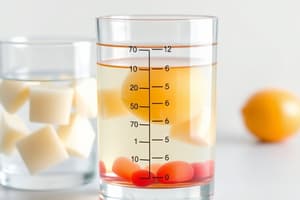Podcast
Questions and Answers
What is the primary action taken to manage hyponatremia?
What is the primary action taken to manage hyponatremia?
- Administer hypertonic saline solutions
- Decrease oral Na+ intake (correct)
- Increase oral Na+ intake
- Provide IV NaCl infusion
What are the signs and symptoms of hypernatremia?
What are the signs and symptoms of hypernatremia?
- Decreased urine output and lethargy
- Nausea and vomiting
- Thirst and confusion (correct)
- Muscle cramps and bradycardia
Which of the following conditions may cause hypernatremia?
Which of the following conditions may cause hypernatremia?
- Adrenal insufficiency
- Fluid overload
- Excess oral/IV Na+ intake (correct)
- Hypovolemia
What diuretic is specifically mentioned for increasing sodium loss in the urine?
What diuretic is specifically mentioned for increasing sodium loss in the urine?
What should be avoided in the management of hypernatremia?
What should be avoided in the management of hypernatremia?
What is the correct treatment for SIADH?
What is the correct treatment for SIADH?
Hypernatremia is defined as sodium levels greater than 135 mEq/L.
Hypernatremia is defined as sodium levels greater than 135 mEq/L.
What is the normal range for potassium in mEq/L?
What is the normal range for potassium in mEq/L?
The symptoms of hypernatremia include __________ and agitation.
The symptoms of hypernatremia include __________ and agitation.
Match each cause of hypernatremia with its description:
Match each cause of hypernatremia with its description:
Flashcards
Hypernatremia
Hypernatremia
A condition where the body has too much sodium in the blood.
Hyponatremia
Hyponatremia
A condition where the body has too little sodium in the blood.
Antidiuretic Hormone (ADH)
Antidiuretic Hormone (ADH)
A hormone produced by the posterior pituitary gland that helps regulate water balance in the body.
Syndrome of Inappropriate Antidiuretic Hormone Secretion (SIADH)
Syndrome of Inappropriate Antidiuretic Hormone Secretion (SIADH)
A condition where the body produces too much ADH, leading to fluid retention and diluted blood.
Signup and view all the flashcards
Potassium (K)
Potassium (K)
A major intracellular cation (positive ion) that is essential for fluid balance, muscle contractions, and nerve impulses.
Signup and view all the flashcards
Hypophysectomy
Hypophysectomy
A surgical procedure that removes the pituitary gland, often performed to treat conditions like tumors or hypersecretion of hormones.
Signup and view all the flashcards
SIADH (Syndrome of Inappropriate Antidiuretic Hormone Secretion)
SIADH (Syndrome of Inappropriate Antidiuretic Hormone Secretion)
A condition where the body produces too much antidiuretic hormone (ADH), leading to fluid retention and diluted blood.
Signup and view all the flashcards
ADH Antagonist
ADH Antagonist
A medication that blocks the effects of antidiuretic hormone (ADH), often used to treat SIADH.
Signup and view all the flashcards
SANSCA (Tolvaptan)
SANSCA (Tolvaptan)
A diuretic medication that increases sodium excretion in the urine.
Signup and view all the flashcards
Hypernatremia Signs and Symptoms
Hypernatremia Signs and Symptoms
Common symptoms associated with high levels of sodium in the blood (Hypernatremia) include thirst, confusion, restlessness, agitation, and sometimes hypertension.
Signup and view all the flashcardsStudy Notes
Fluid and Electrolyte Imbalances
- SIADH (Syndrome of Inappropriate Antidiuretic Hormone): Excessive antidiuretic hormone (ADH) production by the posterior pituitary gland (hypophysis). A hypophysectomy (surgical removal of the pituitary gland) can be a cause.
- Management: Increased oral sodium intake, decreased fluid intake, diuretics if hypervolemia present, ADH antagonists (e.g., tolvaptan/SANSCA). If due to hypovolemia, IV NaCl infusions at a slow rate or only in critical situations, to avoid fluid overload. Monitor closely and avoid rapid administration. Sodium capsules (similar to mothballs), and hypertonic saline solutions are used.
- Treatment: Sodium capsules, hypertonic saline solutions.
Hypernatremia (>145 mEq/L)
- Definition: Sodium levels greater than 145 milliequivalents per liter.
- Causes: Increased oral/IV sodium intake (especially rapid intravenous solutions, check for patient sodium intake with PNSS). Excess hypertonic IV fluids, fever, watery diarrhea, dehydration, overproduction of aldosterone (Cushing's syndrome), gastrointestinal tube feedings, and impaired thirst.
- Signs and Symptoms: Thirst, agitation, confusion, irritability, restlessness, hypertension, fluid retention, and decreased urine output.
- Management: Decrease oral sodium intake. If due to fluid loss, administer IV infusions slowly to avoid cerebral edema. If due to decreased sodium excretion, provide diuretics that increase sodium loss (e.g., tolvaptan/SANSCA).
Hyponatremia
- Avoid this condition.
Hypernatremia: Food Sources
- High sodium foods include soups, canned foods, ham, bacon, sausage, processed foods, cheese, dressings, pizza, hot dogs, and cold cuts.
Potassium
- Symbol: K (Kalium)
- Function: Major intracellular cation, regulates fluid balance, muscle contractions, blood pressure, and nerve impulse transmission.
- Normal Value (NV): 3.5 - 5 mEq/L.
- Inverse Relationship: Inverse relationship with sodium.
- Similarities: Similar functions to magnesium.
- Hypokalemia: A possible issue associated with Potassium imbalances.
Studying That Suits You
Use AI to generate personalized quizzes and flashcards to suit your learning preferences.




